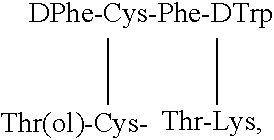Compounds and method for the prevention and treatment of diabetic retinopathy
a technology of diabetic retinopathy and compounding, applied in the direction of peptide/protein ingredients, drug compositions, peptide sources, etc., can solve the problems of insufficient current treatment options, affecting the treatment effect, so as to prolong the delivery of growth factor inhibitory peptide drugs, halt, slow or delay the progression of diabetic retinopathy, and enhance the delivery of peptides
- Summary
- Abstract
- Description
- Claims
- Application Information
AI Technical Summary
Benefits of technology
Problems solved by technology
Method used
Image
Examples
example 1
Synthesis of mono-Boc-sandostatin
Sandostatin (102 mg, 0.10 mmol) was dissolved in 80 ml of water, then mixed with 100 ml of freshly prepared pyridine and 10 ml of TEA. Then 20 ml of cold aqueous solution containing BocN.sub.3 (1.50 ml, 10.60 mmol) was added at once and the solution was stirred at room temperature for 2 hours. At the end of this time, NH.sub.4 OH (3.4 ml, 50 mmol) was added to the solution, which was stirred for an additional 30 minutes. Another 3.4 ml of NH.sub.4 OH was then added and the solvent was removed on a rotary evaporator. The residue was washed once with 100 ml of ethyl ether and purified on a C-18 column, eluted with 50%-60% acetonitrile, 0.5% HOAc aqueous solution. Fractions containing product were freeze-dried, neutralized, and dried again. 90 mg of pale yellowish solid was obtained in a yield of 80.3%. HPLC showed it was pure and it was confirmed by FAB-MS: [M+H.sup.+ ] at m / z 1119. The product has the structure: ##STR60##
Synthesis of Nic-Pro-Pro-OH
Dri...
example 3
Synthesis of Nic-Pro-Pro-(mono-Boc-sandostatin)
TFA-Nic-Pro-Pro-OH (155.0 mg, 0.36 mmol) and HOBt (48.6 mg, 0.36 mmol) were dissolved in 5 ml of DMA, the solution was cooled to 0.degree. C. and DIC (45.4 mg, 0.36 mmol) was added. The resultant solution was stirred at 0.degree. C. for 10 minutes and then at room temperature for 20 minutes. Then, mono-Boc-sandostatin (214 mg, 0.18 mmol) was added and the pH was adjusted by 8-8.5 by adding DIEA. The reaction mixture was stirred at room temperature for 120 minutes. HPLC showed the reaction was complete within 1 hour. The mixture was diluted with 8 ml of 35% acetonitrile, 0.5% HOAc aqueous solution, applied to a C-18 column and eluted with 35-50% acetonitrile, 0.5% HOAc aqueous solution; fractions containing the product were combined and freeze dried twice. 165.0 mg of white solid (7.0 mg) was obtained in a yield of 64.7%. HPLC gave only one peak and the product was confirmed by the Electrospray ionization (ESI) mass: [M+H.sup.+ ] at m / z ...
example 4
##STR62##
To a flask containing the product of EXAMPLE 3 (80.0 mg, 56 .mu.mol), there was added a mixture of TFA (1.9 ml), H.sub.2 O (0.10 ml) and indole (19.5 mg, 167 .mu.mol) under argon. The reaction mixture was stirred at room temperature for 20 minutes. The solvent was then removed with a stream of argon, EtOEt (30 ml) was then added, the mixture was stirred for another two minutes at room temperature and then was stored at -15.degree. C. for 20 minutes. The white precipitate which formed was collected by centrifuging the cooled solution, and was then dried under vacuum over NaOH for 1 hour.
The residue was dissolved in DMA (1.4 ml), DIEA was then added until the pH was 8.5, and DMA solutions of cholesteryl chloroformate (28.3 mg, 63 .mu.mol) and DIEA were added alternately (to maintain the pH at 8-9) over a period of 15 minutes. The mixture was then stirred at room temperature for 40 minutes. Ninhydrin test showed no free amino group was remaining.
This mixture was diluted with 7...
PUM
| Property | Measurement | Unit |
|---|---|---|
| temperature | aaaaa | aaaaa |
| flow rate | aaaaa | aaaaa |
| pH | aaaaa | aaaaa |
Abstract
Description
Claims
Application Information
 Login to View More
Login to View More - R&D
- Intellectual Property
- Life Sciences
- Materials
- Tech Scout
- Unparalleled Data Quality
- Higher Quality Content
- 60% Fewer Hallucinations
Browse by: Latest US Patents, China's latest patents, Technical Efficacy Thesaurus, Application Domain, Technology Topic, Popular Technical Reports.
© 2025 PatSnap. All rights reserved.Legal|Privacy policy|Modern Slavery Act Transparency Statement|Sitemap|About US| Contact US: help@patsnap.com



